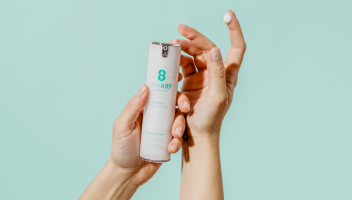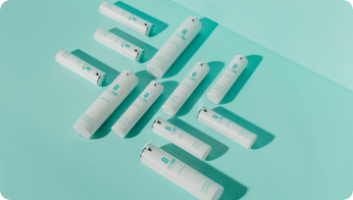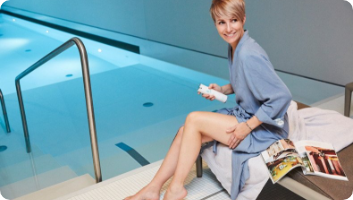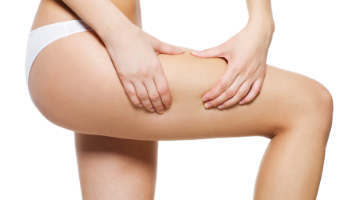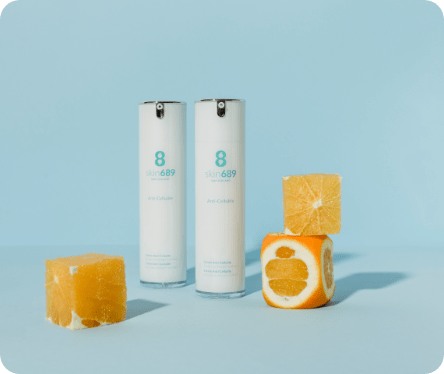Cellulite is not a disease, but a change in the subcutaneous tissue that leads to visible dents and occurs more frequently with age.
These skin changes can be genetic or hormonal and mainly affect women. Even if this is a natural, biological phenomenon, the so-called "orange peel" is often perceived as an aesthetic problem. Above all, legs and Buttocks with cellulite affected by it.
A healthy diet and regular exercise are always good, but the appearance of cellulite can only be positively influenced to a limited extent - the body has difficulty accessing the fat cells in the affected areas and the connective tissue can hardly be strengthened in this way. The exact causes, what actually helps against it and much more can be read here.
1. What are the causes of cellulite on the bottom?
Cellulite in general describes an uneven distribution of fat cells in the connective tissue of the skin. The fat cells can easily push up through the soft skin and the fatty tissue of the subcutis penetrates into the upper layers of the skin and causes visible dents to form.
With increasing age, the skin's elasticity decreases and the fatty tissue can spread, causing the connective tissue strands to weaken. Cellulite in women, it occurs more often on the thighs and in the buttocks area and this is due to the weak connective tissue and the female sex hormone estrogen. Because the more fat the skin cells store, the greater the pressure on the surrounding tissue. Thus, every woman can be affected by cellulite, regardless of body weight. The reason for this is often a combination of a wide variety of triggers. The risk factors include, for example, a high body fat percentage, lack of exercise, stress, poor diet with high-fat and high-sugar foods, excessive alcohol consumption and hormonal influences. Regular smoking can also promote the development of this, because nicotine constricts the blood vessels and damages the collagen structure of the connective tissue.
Basically, a firm butt skin that is not affected by cellulite has a balance of fat lobules and collagen fibers. With severe cellulite, however, the balance is disturbed because enlarged fat lobules press against the epidermis from below and only weak collagen fibers are present. When the collagen fiber network can no longer withstand this pressure, these unwelcome changes occur in the buttocks and legs.
2. What are the symptoms of cellulite on the buttocks?
The only symptom is visible rippling of the skin's surface in certain places. It occurs wherever many fat cells are stored in the lower layer of the skin. However, cellulite neither causes pain nor does it affect the function of the skin.
Depending on the stage of cellulite, different signs can also become visible.
• Stage I
The skin dimples only become visible when the muscle is tense, for example when a fold of skin is pinched together with two fingers. When lying down, on the other hand, no dents can be seen, since it is a matter of slight structural cellulite. Under the skin, the connective tissue strands are partially shortened here.
• Stage II
Here, the cellulite is visible both in the relaxed and in the tense state of the gluteal muscles. This form therefore describes a medium structural cellulite, since the volume of the adipose tissue continues to increase and this increase in the volume of the adipose cells results in a compression of the small blood vessels.
• Stage II
In the third stage, the dents are particularly visible and additional hardening under the dents can be felt on the bottom. Even when lying down, the strong structural cellulite is clearly visible. Since the lymphatic and blood vessel circulation is severely restricted, the legs can feel heavy, especially when walking.
Who is often affected by cellulite on the bottom?
cellulite on buttocks affects almost exclusively women, since women's connective tissue is naturally weaker than that of men. Although obesity is considered a supporting factor for the development, it is not a prerequisite. Even particularly slim women can be affected. The connective tissue of men, on the other hand, is designed in such a way that even if they are very overweight, the fat cells are not pressed into the overlying skin layers and cellulite is therefore not visible. Genetic exceptions are rare.
Pregnant women also often have to struggle with cellulite on the buttocks, since on the one hand the tissue is heavily stressed by the strong weight gain and on the other hand there is a major change in the hormonal balance.

3. What can be done against cellulite on the bottom?
The methods to get rid of cellulite on the bottom have become almost unmanageable and range from creams to surgical options. However, very few of them are actually effective.
There is no specific sport that prevents the formation of cellulite. Rather, it is about exercising regularly to boost your metabolism and promote blood circulation. A combination of cardio exercises and muscle-building activities work best for this. Sporting units in which a large number of muscle groups are activated and alternating intensive and relaxing phases are also well suited. With a strengthened musculature, fat cells are reduced and the skin is tightened. Endurance sports, such as swimming or cycling, are also a good way to support strength training.
In the case of stronger cellulite, liposuction can be used under certain conditions, in which excess fat cells are sucked out using cannulas. Depending on the condition of the cellulite on the buttocks, the appearance can be improved, the fat can be sucked off and improved proportions can be made visible.
Laser removal of the fat cells is another procedure. A small puncture is made and the cells are destroyed by the laser light. This is followed by suction of the liquefied fat cells and tightening of the skin. The problem with liposuction, however, is that only excess fat is removed, but the texture of the skin itself is not changed.
Gentle mesotherapy can also be used for aesthetic skin changes, such as cellulite on the buttocks. Mesotherapy can improve the complexion and increase blood circulation. For this purpose, an individually composed mixture of active ingredients is injected into the skin area of the patient using the finest needles. Vitamins and amino acids are used, among other things, to achieve better blood circulation and firmer skin on the buttocks.
Before the invasive procedures, however, it is always important to have a detailed discussion with a specialist in order to determine whether the treatment is suitable in the individual case or whether certain previous illnesses speak against the operation.
It is important to understand that these interventions often involve high costs and, unfortunately, the results often fall short of expectations.
There is no miracle cure for cellulite, but with a combination of a balanced diet, sufficient exercise and some home remedies, a slight improvement can be achieved.
Contrast showers are good for stimulating blood circulation and fat metabolism in the buttocks. Alternating between cold and warm water should end with cold water.
And with a gentle massage of the affected areas, blockages in the blood and lymphatic systems can be released. In this way, the body can access the fat deposits better.
Conventional cellulite creams rely on caffeine as the central active ingredient. This detoxifies the skin, it becomes more compact for a short time and appears a little smoother as a result. However, the effect is only short-lived, as soon as the cream is discontinued, the original condition returns very quickly. The elasticity of the skin and the stored fat cells as the main causes are not addressed in this way.
skin689, on the other hand, has its own patented active ingredient from medical research that acts specifically on the causes of cellulite - weakened connective tissue and unevenly stored fat cells. This targeted, dual mechanism of action has been demonstrated in in-vitro studies. And an application study showed that the appearance of cellulite improves significantly. This improvement was measured in all (!) study participants and increased continuously during use - proof of the structural, lasting effect.
4. How to prevent cellulite on the bottom?
You cannot prevent cellulite, you can only influence a few factors. A healthy diet, exercise and targeted massages can help reduce the development of cellulite.
And finally ...
Cellulite is completely normal and harmless in terms of health. The development is related to weak connective tissue and can be genetic - completely independent of physique. Cellulite can be minimized with a healthy lifestyle including a balanced diet and sufficient exercise. Conventional creams or home remedies can only help to a limited extent. Surgical interventions are out of the question for many, if only in view of the costs - and often do not bring the hoped-for results.
With a new active ingredient skin689 Anti cellulite cream developed that specifically and sustainably tackles the causes of cellulite - weakened connective tissue and unevenly stored fat cells - and can thus significantly improve the appearance.




